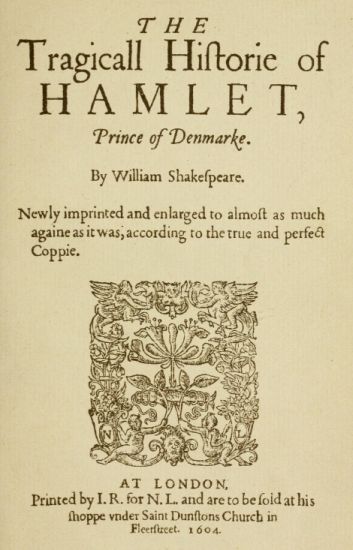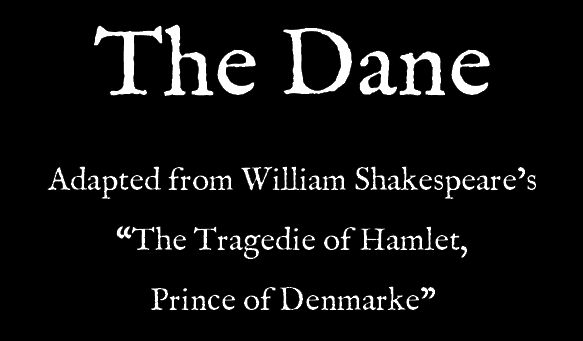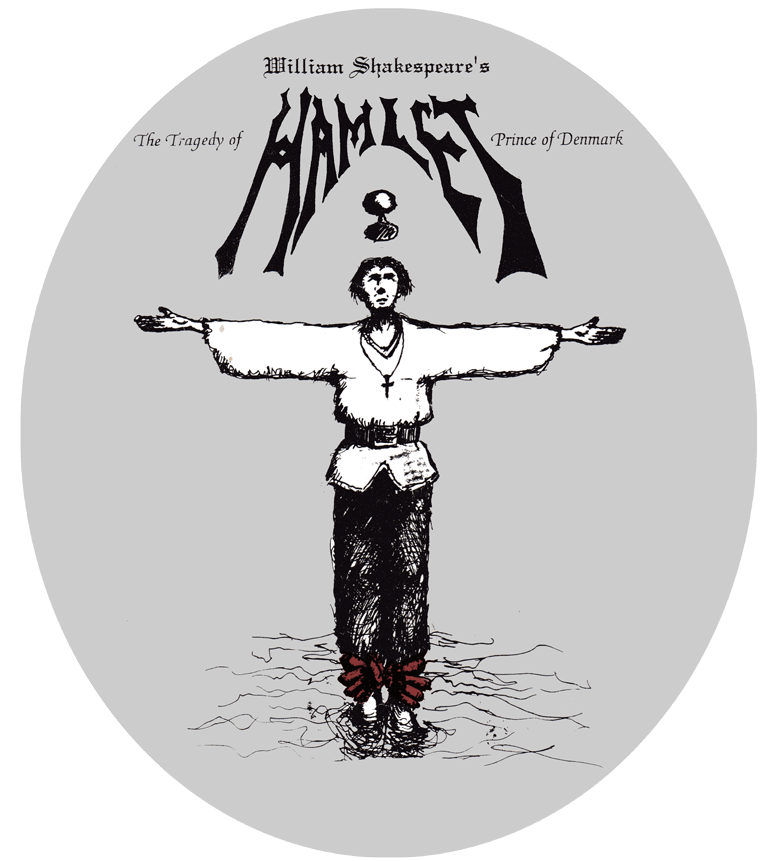Origins
Introduction
This section includes some historical background of where the story of "The Dane" came from and will later be expanded with links to academic resources and study guides, as well as some of the research collected that was utilized in the development of this project.
The Hamlet Legend
Not many people outside scholarly circles realize that Shakespeare got the story of Hamlet from another source. It is derived from the Books of Danish History by Saxo Grammaticus, written around 1185, and published in print for the first time in 1514. It was later recreated in French through Belleforest's "Histoires tragiques", printed around 1572, which is the most likely source of reference for Shakespeare since it would have been in circulation in London.
The parallels between the story from Saxo Grammaticus and Shakespeare's rendition are so strikingly similar they cannot be ignored. Although the names are different (some only slightly such as 'Amleth' vs. 'Hamlet'), the plot points are identical in many ways except for some interesting variations. You can read the story translated into English here: The First Nine Books of the Danish History of Saxo Grammaticus. Amleth is first mentioned on page 106 in the third paragraph.
"It's clear to me that Shakespeare changed the story to suit the tastes of his audience and to reflect contemporary social-political-religious trends. Essentially he "modernized" Amleth into Hamlet. Although "The Dane" is not modernizing the story in that fashion, there are changes to the language, including original material, that will help a modern audience understand Hamlet's story in ways that would otherwise be lost if we strictly stuck to Shakespeare's language. As the director, Christopher Gauntt has said: "In essence, when working on the script, whenever I ran into some sticking points that I thought might be lost on a modern audience, I would ask myself: 'if Shakespeare was alive today, and collaborating with someone like Alfred Hitcock or James Cameron, what changes would he have made for today's audience?'." - CG
For a brief summary of the story of Amlet and even more fun facts about the various legends and possible origins of the Hamlet story, check out this Wikipedia page on the legend of Hamlet.
Shakespeare's Hamlet
Facsimiles of the published plays.
The facimiles are photographic reproductions of the original printed texts. There were many versions of Hamlet that were published in the 1600s, but the most important three in terms of its history and content are the 1st Quarto, the 2nd Quarto, and the version in the 1st Folio, which also contains the rest of Shakespeare's works. Click on the links to see how the text was originally printed.
 |
Hamlet - 1st Quarto (1603)
|
Researching Shakespeare's Handwriting
As part of his research, Christopher Gauntt wanted to study Shakespeare's handwriting. There aren't many examples attributed to him. There are a few pages from a play about Sir Thomas More, and a total of six known signatures, three of which appeared on his last will and testament, the content of which was most likely written by a lawyer, a copy which can be found in the United Kingdom's National Archives. In the process of studying the will, Christopher discovered an error:
"I found the handwriting of the will very difficult to read, and so decided to pair up the translation with the written words using photoshop. To my surprise, there was nearly an entire line that was missing from the translation. I informed the archives of the error, and they sent me an e-mail thanking me, and let me know that the site was updated. I guess I earned a bit of Shakespeare street-cred that day." - CG
Making The Dane
Why we decided to set The Dane in the 1520s
In researching The Dane, the goal was to try to find a historical time frame that was the closest match to the events that take place in the story and parallel the social-political-religious framework of the tale. The early 1520s seemed to be the best fit. A number of historical events have some surprising similarity to key plot points of The Dane and, for all we know, might have influenced some of Shakespeare's decisions on his adaptation of the original:
- Denmark initially controlled the "Kalmar Union" which consisted of Norway, Denmark, and Sweden.
- In January of 1523, the Danish nobles removed Christian II from the throne of Denmark and gave it to his uncle, Frederick I - which is eerily similar to Claudius getting the throne instead of Hamlet. However, Christian II was married with kids and had a bit of a reputation as a tyrant.
- In June of 1523, Gustav I took the throne of Sweden and separated itself from Denmark's rule. They will still fighting over territory, and Denmark still retained control of both sides of the straight where castle Elsinore (Helsingør) is located. This bit of history led to changing the military threat at the beginning of the story to come from Sweden, not Norway as in Shakespeare's version.
- It's nearly midway through Henry VIII's reign in England, who had strong ties with Christian II, including permission to enact piracy against his enemies (meaning Frederick I). This loosely parallel's Claudius' relationship with England when he sends Hamlet there.
- Piracy, both rogue and politically financed, was a major problem all over the European seas.
- While there was quite a bit of rumblings about many of the practices by the Catholic clergy, and had been for some time, the Protestant reformation didn't really kick off until Oct 31, 1517, when Martin Luther posted his 95 Theses on the doors to the church of Wittenberg (where Hamlet was going to school). By the 1520s, the reformation was spreading and gaining influence in Germany, Denmark, Norway, and Sweden. But Catholicism was still the official religion of those countries, and would be for awhile yet. So since most of the religious references are based in Catholic practices, except for Horatio's "philosophy" that Hamlet refers to (which is probably the Protestant faith), this time period would be a good match for The Dane's religious plot points.
Granted, we aren't recreating actual history here. The story is based on tales from many hundreds of years earlier, may. But in order for our adaptation of Shakespeare's adaptation to make the most sense, in our view, it's best to set it in the right place and time so that the audience will see it in the most accurate context possible.
Why choose “ The Dane ” for the title?
From the very beginning, people asked if we planned on calling it "Hamlet" or use Shakespeare's full title "The Tragedy of Hamlet, Prince of Denmark", or something else. After talking to many people, we decided to change the title for various reasons:
- For many people, Shakespeare can be intimidating. 'Hamlet' has an immediate association, and may be a bit of put off to those that aren't already fans. Although we have kept most of the language, we've gone to great lengths to revise bits and pieces as needed so that the film can be understood by a wider audience, regardless of educational background. We decided a shift in title will help reflect that and open up the audience base. Also, we figured those who already enjoy Shakespeare and like Hamlet will probably see the movie anyway, despite the title change.
- This wouldn't be the first time the story has been changed and given a new title. It used to be called Amleth and before that Amlodi before Shakespeare changed it to Hamlet. See the origins of the story above.
- Until we settled on a title, we were just calling it "the Hamlet project" or "Project Hamlet". The actual choice of 'The Dane' came from working on the pre-visualization of the opening sequence, which begins with a sonnet written in Shakespeare's style that sets up the back story. The last line is "This be the tale of Prince Hamlet the Dane". After that line, it goes directly into the title sequence. When spoken aloud, there was something to the ring to it. We experimented with some logo artwork and bounced the idea off of test groups. The response was very positive, so we decided to go with 'The Dane' as the title.
- Although the majority of the material is based on Shakespeare's work and it is probably going to be the most authentic telling of the story ever done, there are enough differences that it would be technically inaccurate to call it "William Shakespeare's 'Hamlet'". So the marketing would go something like this:

- Changing the title also separates it out from other previous adaptations. For instance, if you were to search "Hamlet movie" on the web, a long list shows up. But if you search for "The Dane movie", it shows up within the first ten hits.
- Not that this next point was a deciding factor, but it's an interesting side effect. Supposedly there has been some research that indicates when viewers are browsing through video-on-demand titles, they tend not have gone further than the letter D before they have picked something. This won't come into play until much later in the distribution life-cycle, and we have no idea how to measure the effectiveness of it, but we figure if it helps then it's a bonus.
- "Why not 'Amleth'? That starts with 'A'."... you might be thinking. But Amleth has a different story line than Hamlet, and I don't want there to be confusion between the two.
- With any luck, dog lovers will accidentally go see the movie. (j/k)
The Play's the Thing
Following is a brief description of how initial concept for 'The Dane' came about when Christopher directed a staged production of Hamlet in his senior year at UCLA.
"It all began with a conversation I had with a friend back in 1992 where I randomly decided I would direct whatever Shakespeare play he mentioned next. To my surprise he suggested Hamlet, which ironically I'd never read. I was a senior at UCLA, getting my degree in Theater at the time, so I figured, 'why not?' A good friend and mentor, D.J. Carlisle, suggested some books for me to take a look at, and hinted at looking at the religious angle, rather than the typical Freudian approach. That got me started, and soon I was seeing Hamlet in a way completely different than how it is normally taught. It was during my research in preparation for the play that I stumbled across the little pieces of information that led to my young Hamlet theory. Granted, I'm probably not the first to have thought of this, but it was something I hadn't heard of before, and it made for a fresh and exciting take on the play. It took five months of planning and rehearsing, so it didn't go up until the following year. The production was a great success. Looking back, I sometimes think of it as a dry run for what would become this film project." - CG

Image from the original flyer of the 1993 UCLA theatrical production
